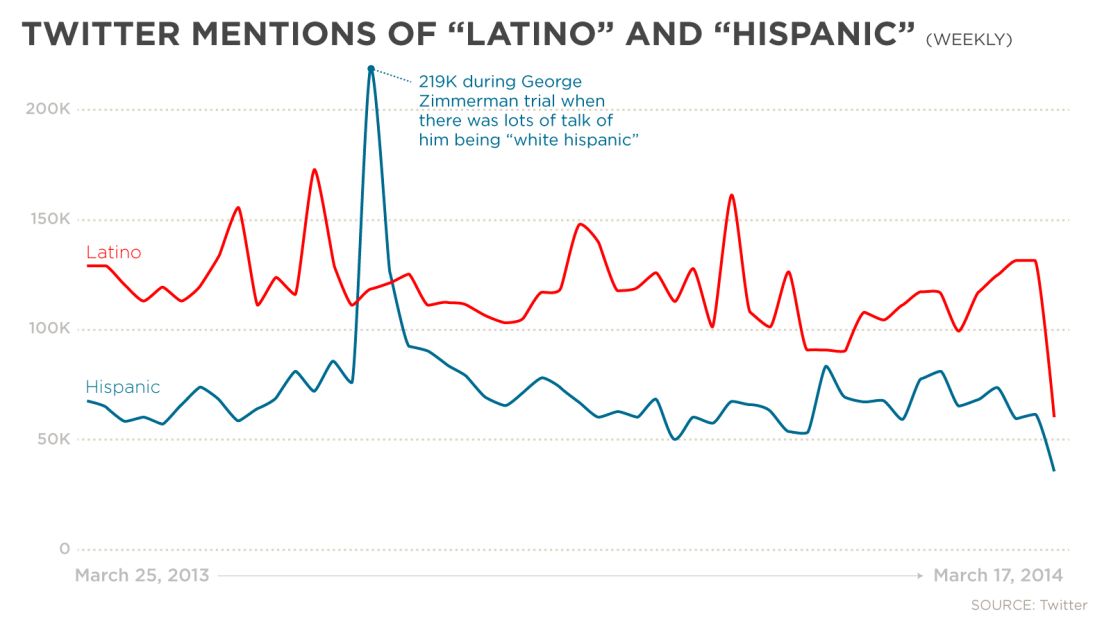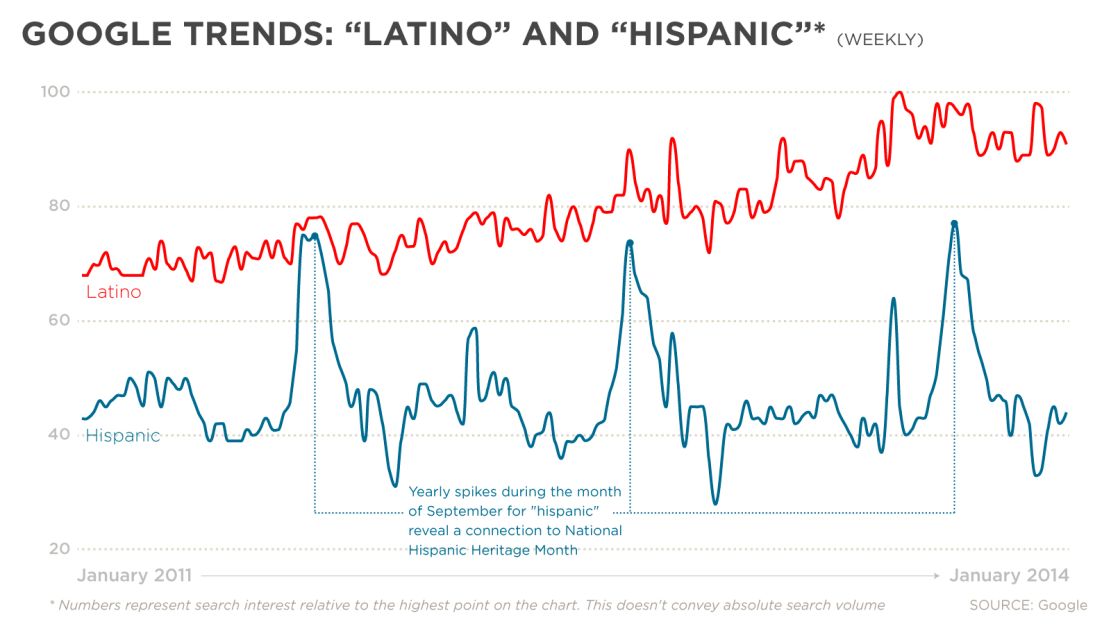Story highlights
Latinos straddle two worlds: where our families came from and where we live
What's the difference between the terms Hispanic and Latino?
For many, using either term to describe this group feels limiting
The plight of the "where are you from" question explained
If there’s one thing everyone should know about Hispanics in the United States, it’s that this rapidly growing minority has an undefined identity crisis.
Why? Because of the confusion surrounding what to call people whose ethnic background is from Latin American and Spanish-speaking countries. Some even feel 100% American or 100% Latino – or Hispanic, depending to whom you’re talking.
How do you know which term to use? “Hispanic” and “Latino” are often used interchangeably and aim to describe the same group of people, but technically they do not mean the same thing.
What’s more, within Hispanic communities in the United States, most people identify with their country of origin and often use hyphens to represent their loyalties to both cultures: like “Mexican-American.”
We’re constantly having to straddle two worlds: the one where our families came from and where we’ve chosen to live.
To make matters even more complicated, all that can change depending on where Latinos are in any given moment.
When I’m in my parents’ native country of Peru, I’m American with Peruvian parents and that’s that. No matter how hard I’ve tried to be “Peruvian enough” to my fellow Peruvians, I might as well be a gringa in their eyes.
Share your immigration story with CNN iReport
And, when I’m back in United States, someone will inevitably ask me where I’m from in a way that suggests I’m not from the good ol’ U.S. of A.
In other words, imagine having to constantly tell people that you’re made of two colors: blue and yellow, but all people see is green, and you constantly have to go in the light and show them you are made of both colors.
Identifying as Hispanic or Latino comes with its ups and downs. But perhaps breaking down what these terms mean and how they’re used within this diverse community of 54 million Latinos can help shed some light on our experience.
Hispanic or Latino?
Years ago, I attended a media networking event hoping to meet more established journalists.
I remember saying something along the lines of, “Ah, the joys of being Hispanic,” and an older Latina woman turned around and said, “No, sweetie, you are a Latina. Don’t refer to yourself as Hispanic. The government invented that word for us.”
Um, OK. I think I hit a nerve.
Then, a younger Latino man snickered and asked her to not take those labels so seriously. She quickly turned to him and, judging by her wide eyes and stiff demeanor, she clearly did not agree. Her eyes then met with mine and she looked at me as if I had to make a choice: Hispanic or Latino? What’s it going to be?
The room immediately felt as if it divided into two uncomfortable teams.
I could feel the warm embrace from the “Hispanic team,” which was easygoing and used both terms interchangeably, and imagined them saying to me, “Come on over! Hispanic? Latino? Whatever you feel is best.”
But the looming eyes of “Latino team” made me feel obligated to side with them and take some kind of political stance on the term. Using Latino had a slight “sticking it to the man” feel.
I wasn’t sure how I felt about identifying with either term, so I decided to hold my tongue, take a deep breath and smile.
Even though this woman I had never met tried to impose her label on me, she was partially right.
The term Hispanic was first used by the U.S. government in the 1970s in an attempt to count people from Mexico, Cuba and Central and South America but what she failed to mention was that the term has existed for centuries.
Back then, there wasn’t a private or public sector that had a uniform way of collecting data on the Hispanic community, so a committee was formed and it opted not to use Latino because, if taken literally, it could include Europeans of Latin origin.
The goal was to accurately account for this growing and discriminated against population so laws could be implemented to help with their needs as well as trace their accomplishments.
The term Latino finally came to fruition in the 2000 census as a more inclusive way to include mixed races known as “mestizo” or “mulato” in Central and South America.
In short, Hispanic refers to language and Latino refers to geography.
One reason for my ambivalence with both these terms is that I didn’t grow up using either one.
I was born and raised in New Jersey by my Peruvian immigrant parents in a predominantly Hispanic community where everyone identified with their family’s country of origin. I was Peruvian for the better half of my life and it’s perhaps why I use the terms interchangeably and have no preference.
I’m not alone.
Most Hispanics in the United States prefer to use their country of origin to describe themselves most often. About half said they have no preference for either term but for those who did, Hispanic was preferred over “Latino,” according to the Pew Research Center.
“For example, in California, the state with the largest Hispanic population, 30% say they prefer ‘Hispanic’ and 17% say they prefer the term ‘Latino,’” according to Pew. The results were similar in Florida and New York.
The only exception is Texas where there was an overwhelming preference for “Hispanic.” Among Hispanic Texans, 46% prefer the term Hispanic, while 8% say they prefer Latino.
But this wasn’t always the case.
“There was a time when Latino was primarily used in the West Coast and Hispanic on the East Coast,” said Mark Hugo Lopez, director of Hispanic Research at the Pew Research Center.
The use of both pan-ethnic terms are unique to the United States, Lopez added, as is the ongoing identity debate on which term to use.
Latino vs. Hispanic on social media
Latinos are the most active of all ethnic groups on social media networking sites – Hispanic adults topping at 72%, followed by African Americans at 68% and whites at 65% – and CNN recently looked into which term was used more often and in what state across the country.


Even though Pew found that Hispanic was preferred over Latino when it came to identity, in the past year, CNN found that Latino was mentioned more on Twitter than Hispanic.
“From what I’ve seen, the term Hispanic inspires more rage than Latino,” said Adrian Carrasquillo, former social media manager at NBC Latino and now editor of Latino coverage for BuzzFeed.
“For a long time the Latino community has been fragmented, but now they are starting to have more cohesion and the rise of Latino is bringing people together more,” he added.
The term’s popularity may also have to do with the sudden surge of niche sites that containin the term, like Fox New Latino or The Huffington Post’s LatinoVoices or two new magazines: Cosmopolitan for Latinas and Glam Belleza Latina.
CNN found the states where Google users searched the most for the term Latino from 2011-2014 were Virginia, California, Texas, Florida, Arizona and New York. The states with the highest Google searches for Hispanic were New Mexico, Texas, District of Columbia, Florida and Arizona.
Google searches for Hispanic have declined over the past 10 years, while searches for Latino have remained steady and even seen an uptick in the past two to three years. The only exception each year was during Hispanic Heritage Month.
“Groups like Latinos in Social Media and niche Latino sites that have launched recently have a lot to do with Latino being used more than Hispanic, but Latino refers to flavors, people and music. You don’t hear people say ‘Hispanic music,’ they say ‘Latino music,’ ” said Joe Kutchera, author of “Latino Link: Building Brands Online with Hispanic Communities and Content.”
“Latino media outlets have turned to Latino more because the term feels more inclusive, but that can always change. Younger generations are generally more accepting and don’t care as much about these labels,” Kutchera added.
Such was the case for Lance Rios when he started the popular Latino-based community Facebook page Being Latino. He said he realized Latino held more weight than Hispanic because it was a term embraced within the community.
“Twenty years ago Chicanos were Chicanos, and Boricuas were Boricuas but now it’s different,” Rios said. “Latino encompasses many more who can identify with having parents from different parts of Latin America.”
Hispanics in the United States: Fast Facts
That annoying question: Where are you from?
Marco Perez, founder of the United Latino Professionals, has developed a good-natured sense of humor when he is asked a question that many Latinos often hear: Where are you from?
Perez said the question doesn’t bother him much anymore.
“I just say I was born in Guatemala but was raised in New York since I was toddler so I identify myself more with ‘American’ culture,” Perez said.
It’s clearly not a one-word answer for Perez but not as complicated as some make it out to be.
“Their reaction always depends on who it is, their level of education and what part of the country I’m in. But I get reactions such as, ‘No, I mean ethnic origin,’ but in many cases they simply leave it at an awkward, ‘Oh OK,’” Perez said.
There are a couple of reasons why this question is irritating to many Latinos. It implies that the person being asked is a foreigner when he or she, or his or her family, could have easily been in the United States for several generations.
It also inevitably puts Latinos in a box, making them feel singled out and forced to justify their American-ness.
Before I knew any better, the question also made me feel foreign, so I always had my Americana spiel ready to go: “Yes, I’m Peruvian but I was born and raised in New Jersey. And, I went to Rutgers, and watched ‘Full House’ and ‘Saved by the Bell’ growing up. I love apple pie and spend Fourth of July weekend down the shore, etc.”
‘Where are you from?’ is not the right question
The only time I feel like I’m identifying with the Hispanic or Latino label is when I’m around non-Latinos or filling out the census survey.
Living in two worlds
With all the “Latino boom” talk, I realized I am a part of the population that isn’t just part of the changing face of America but that also is altering its economic landscape.
You’ve heard the statistics: Latinos have a $1 trillion buying power only expected to grow. The Latino vote helped Obama get elected in 2008 and 2012. They’re one out of every six people, one out of every four babies born each year.
The Hispanic population accounted for more than half of the country’s growth in the past decade as well as 95% of the teen population growth through 2020. And, by 2050, Latinos are projected to make up 30% of the U.S. population.
That’s what Hispanic marketing expert Chiqui Cartagena calls the duality of the Latino reality.
“From the grocery aisle where you pick up your Corona beer and your dulce de leche ice cream, to the Billboard charts where Pitbull, Marc Anthony and Jennifer Lopez routinely dominate, to the lunch you order at Chipotle …. the Latino effect is everywhere,” wrote Cartagena, the vice president of corporate marketing for Univision Cartagena, in an op-ed for CNN.
When companies talk about the Hispanic market, they are referring to the bilingual Latino who has embraced both cultures, eats pizza and tacos, and the growing share of Hispanics who prefer to consume their news in English from television, print, radio and Internet outlets.
But Pew also found that most Latinos acknowledge the importance of speaking Spanish and found that more than 34 million Hispanics ages 5 and older spoke Spanish at home, which may be the reason why English and Spanish have influenced each other so much.
Fewer Latinos will speak Spanish, more non-Latinos will, report says
Language isn’t the only aspect of Latino culture to keep in mind when speaking to this growing community in the United States. It’s also important to know that Latinos are not a monolithic culture.
While a large percentage of the Hispanic market is of Mexican origin, there are still two dozen other nationalities that make up America’s Latino population. Also, Latinos come in all shapes, complexions and sizes.
Glenda Guevara has little patience for stereotypes these days.
“I now take the ‘where are you from?’ as a teaching moment,” said Guevara, who was born in El Salvador. “But I do get furious when I’m told that I can’t be from El Salvador because I don’t fit the ‘look.’”
Without completely losing her cool, Guevara continually responds by asking, “What exactly does an El Salvadoran look like? Please tell me what my people should look like?”
Latin America’s diverse racial demographics are the result of a mixed-race background of European, African and indigenous cultures.
All the attention Latinos have gotten over the years has come with its fair share of stereotypes and misconceptions, some I’m able to laugh off and some I wish I could wave a magic wand and change immediately, like:
Being asked to say something in Spanish (Nope, I’m not here solely for your entertainment.), to explain where exactly Peru is (Don’t admit the little geography you know.), if I know someone you once met in Peru (It’s a big country, the chances are impossible.), if I’m a U.S. citizen (That’s never, ever appropriate.), and – my personal favorite – introducing me to your friend from a Latin American country because you believe we will hit it off. (Common backgrounds don’t necessarily mean you are introducing me to my future bestie.)
These awkward and often staggering encounters only confirm how ambiguous Latinos’ collective identity is to those on the outside.
But if waving that wand meant having to alter who I am or how I move seamlessly between two worlds, then I’d hold back. I can only hope that as the Hispanic community continues to grow, so will a more defined identity.
Study: Hispanics show increasing cultural, economic and social diversity
How do you identify and why? Please share your thoughts in the comments!








